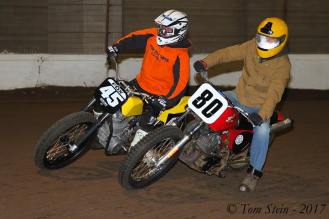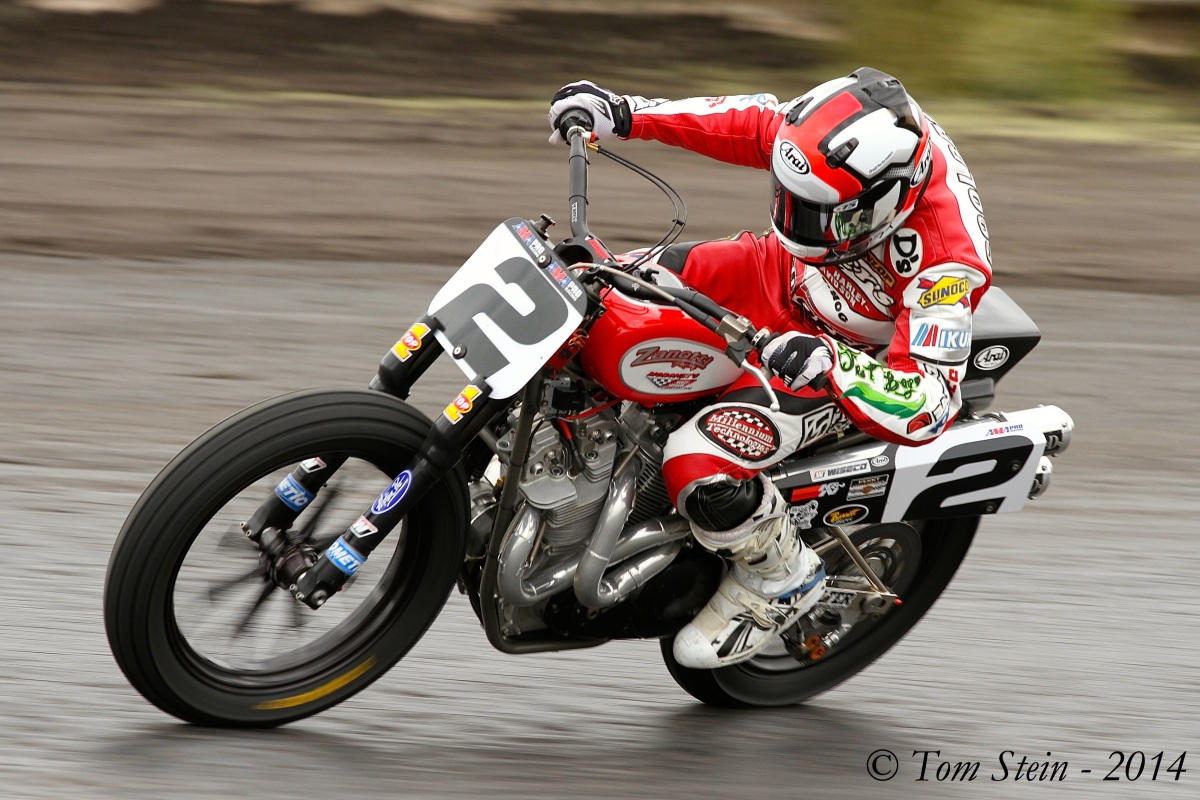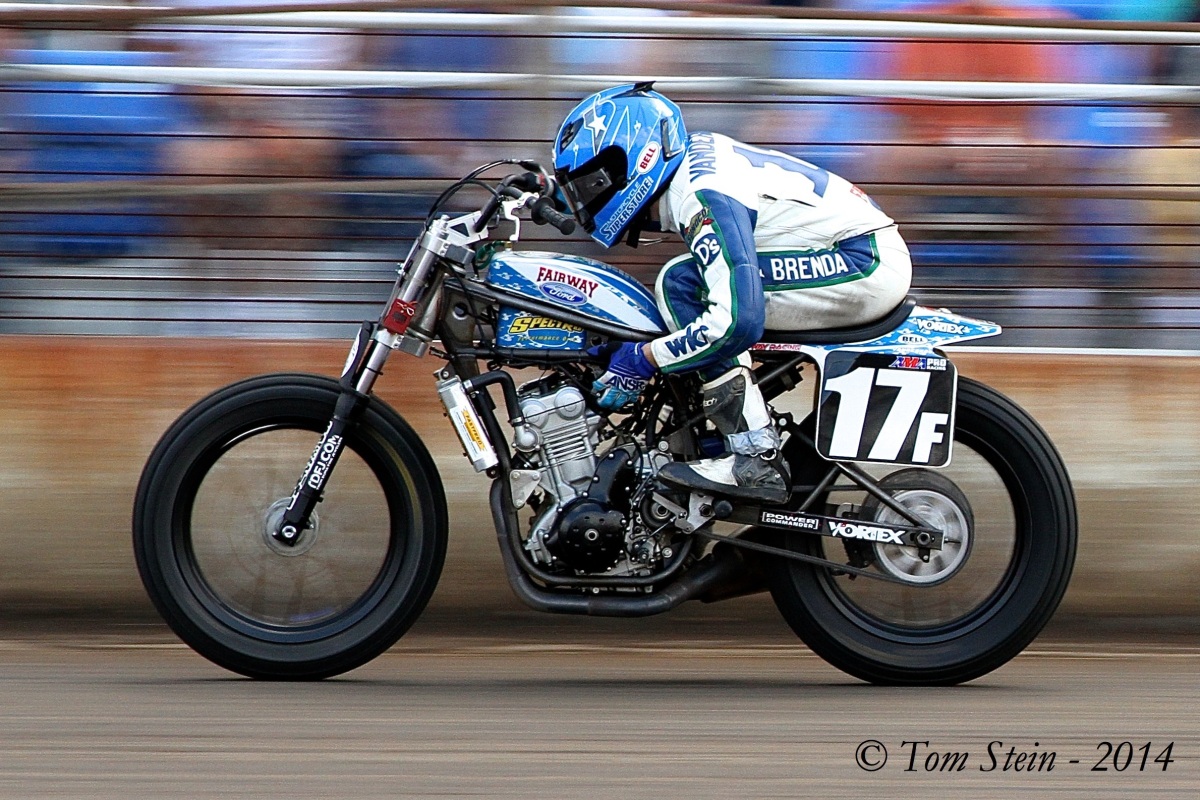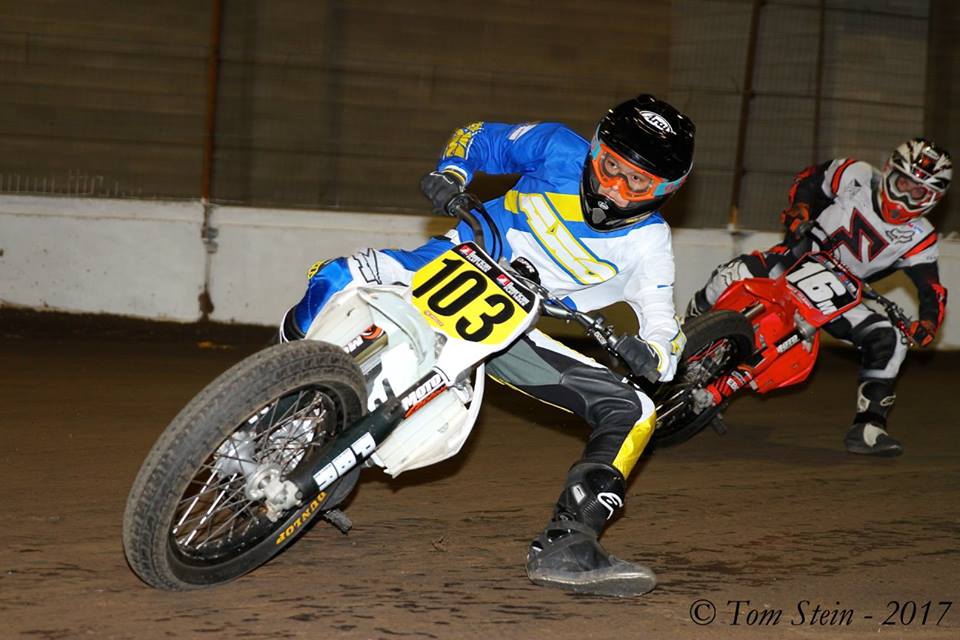Even before I started digging into this whole Salem flat track thing, Tom Stein’s photography was on my radar. I’d catch his shots on rider’s Facebook profiles or in Northwest race reports; crisp action shots of steely-eyed riders cutting diagonally into frame, everything around them blurred by speed, dirt and ambition.
Tom’s images have become synonymous with the Salem winter races. Before my first night there, his pictures were the only hint of what I could expect once I got on the oval. Any website on the Salem races would usually be paired with his pictures, clearly showing that the racing didn’t stop in Oregon just because you can’t feel your toes. So it came as no surprise to see him snapping pictures on turn three during the opening night races in Salem.

The next day I hammered the refresh button on his Facebook page for hours until images started to appear. He shoots everyone, from amateur riders in foggy helmets to the professional flat trackers who are the real draw. His pictures make the slow look fast and the fast look mean. I clicked on every one.
I’m new to this entire scene, so it was great to learn a little about the man behind the lens. I sent Tom some questions about his background, his process and his love of racing in the Pacific Northwest, and he graciously answered them all.
Images included in this were shared by Tom – click on them to make them bigger and soak in that racing action. You can purchase high-res versions of any of his photos at www.tomsteinphoto.com.
How did you get involved in the Pacific Northwest racing scene?
I’ve lived near Portland all of my life. I grew up in the 60’s and 70’s when you could still ride dirtbikes near Skyline Boulevard in the West Hills. I got my first lawnmower-engine minibike when I was 10 or 11 and have been on two wheels ever since.
I have been interested in racing ever since I was a little boy. Building model cars and watching ABC’s Wide World of Sports really lit my fire. I remember my dad taking me to see drag races at Portland International Raceway. Flat track racing intrigued me very early on, but I had no path for involvement until I was grown up and on my own.

When did you start racing?
I did not start racing until my late 20’s. I’ve raced in off-road events, motocross and flat track and just a little Supermoto. One of my kids once said that I was medium-fast. I took that as a compliment. I finished well in my class when the AMA National Amateur Dirt Track Championships were held in Washington in 1988.
My off-track involvement in racing began in the mid-70s, when I became a corner worker at the sports car races in Portland. I worked in various roles besides flagging, and got to be up close to SCCA, Trans-Am, IMSA and CART events.
In the 80’s, a racer friend invited me to help with the OMRRA motorcycle road races at Portland International Raceway (PIR). I served in various positions for about a decade, including a time as the club’s president. OMRRA worked with WERA and Formula USA during those years to host joint events at PIR.
In the 2000’s I worked as the start/finish flagger in the Supermoto USA NW series in Oregon and Washington.
I’ve been married to my lovely wife for nearly 30 years and have two great stepsons. By day, I’m an Insurance Claims Adjuster, and I probably take a hundred or more photos of damaged property each day.
Just about every moment outside of work is connected to motorsports in some manner.

Can you talk a bit about your background in photography?
My father was a prolific photographer. He took lots of photos in his work as a civil engineer, and an engineer’s desire for accuracy and realism informed his approach. That approach rubbed off on me, I suppose.
I don’t have any formal photography training beyond a couple of really fun terms in high school. I do study the work of others to learn technique and to gauge my progress, and I also study informally online and through library resources to improve my skills. I pay close attention to the basics of exposure, shutter speed, light sensitivity and composition.

What do you use to shoot?
I have a Canon 7D camera body. I use it with two Canon lenses, an EF24-70mm f/2.8L ll USM, and an EF70-200mm f/2.8L IS ll USM. This is a popular basic setup for sports photography. I also use a Canon 580 EXII flash unit.
I like to keep the process simple. I do not shoot in RAW and I use iPhoto for simple editing.
To me, a good photo is one which shares a compelling story, feeling or moment of action and is well-composed, properly exposed and in focus. In racing photography, that usually means conveying a sense of motion or speed in the still image.

How do you achieve such clear action shots?
Taking photos of fast-moving objects in a dim light is difficult work. Salem is a dark arena. You really need to be up close to the action to get clear, well-lit shots.

I stick to the 24-70 lens at Salem and I use the flash. Flash lighting is not usually allowed at traditional sports such as baseball and football but it is nearly always allowed at racing events. Most of the racers I’ve spoken to say they don’t even notice it at all. I never noticed it when I was racing, but I don’t think I was photographed very often, either.
It’s a good day when I can achieve a 15% “keeper” rate at the races — 15 out of 100 photos that I’m not embarrassed to show to others, and perhaps one or two of that I’m proud of. As with many people who create things, I think I’m more aware of the flaws in my work than a casual observer might be.
What do you enjoy most about photographing the Pacific Northwest race scene?
I stopped racing about five years ago. Photographing and reporting on races has been a great way to stay involved and to get a seat on the good side of the fence. I cover professional and amateur events all across the country, posting photos, race reports and other news items on my Facebook page called Northwest Track Shots. People are welcome to download, share and save the watermarked photos that I place there. I also maintain an online purchase site, tomsteinphoto.com, where people can buy prints and other products.

I’m pleased that people seem to enjoy my work. Selling photos was not the motivation for this project, and in fact it is a very small part of what I do. This is an expensive hobby for me, but it’s less expensive that actually going racing, and with a lot of the same benefits. I get to be incredibly close to the action and the participants and I get to share that experience with others.
I just love that I can help to enhance people’s racing experience and help to preserve their racing memories.
Any tips for photographers who want to capture photos at races?
To the aspiring photographer I would say take pictures of the things that interest you. Become familiar with your equipment and its various settings, regardless of whether you’re using a fancy DSLR or your phone. Read the instruction manual. Practice a lot. You never have to worry about running out of film with digital cameras.
A good resource on photo theory and technique is Bryan Peterson’s book, “Understanding Exposure“. It’s written in plain language and is highly regarded as a source of important basic information.

What do you like about the Salem Winter Series?
The Salem series is appealing to me because it’s very well run and very safe. I love all of the people there. The track is large for an indoor circuit which makes a nice contrast to the smaller indoor track in Puyallup. Both tracks have fun characteristics and good organizations behind them. Having this variety of choices is really good for the local sport, don’t you agree?
Through all of this, the best part has been the people I’ve met. I have made lifelong friends through racing, and enjoyed working with other dedicated people to organize races and ensure that racers and fans had a safe and fun time. Guiding my own kids into riding and racing was rewarding. Competing with others and occasionally poking someone with my elbow at a short track race is just the best fun.
The PNW has had a vibrant racing scene for ages and I’m just glad to have a small role in it. Racers and the other people who love racing are the best people of all.
I want to give a big thanks to Tom for giving me his time for this interview. Be sure to follow Northwest Track Shots on Facebook, and check out Tom’s website at www.tomsteinphoto.com.





It’s always nice to see Tom at the track smiling and greeting the racers. He helps bring flat track back in the face of the public with his pictures. He’s an all-around great guy has a cool bike collection travels around to a lot of the races and brings them back to us That can’t be there so we can enjoy thank you Tom .
Well said, Rick!